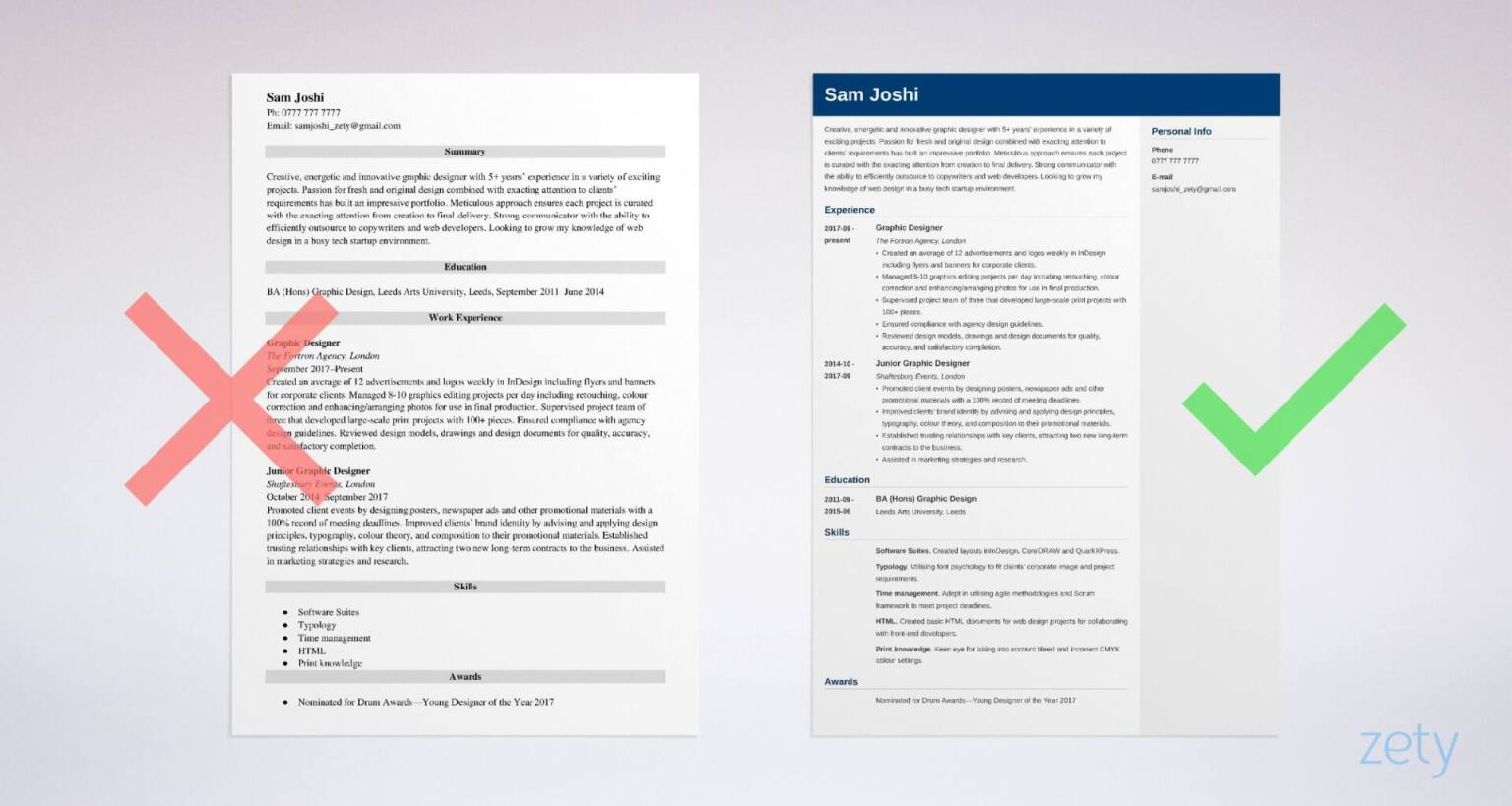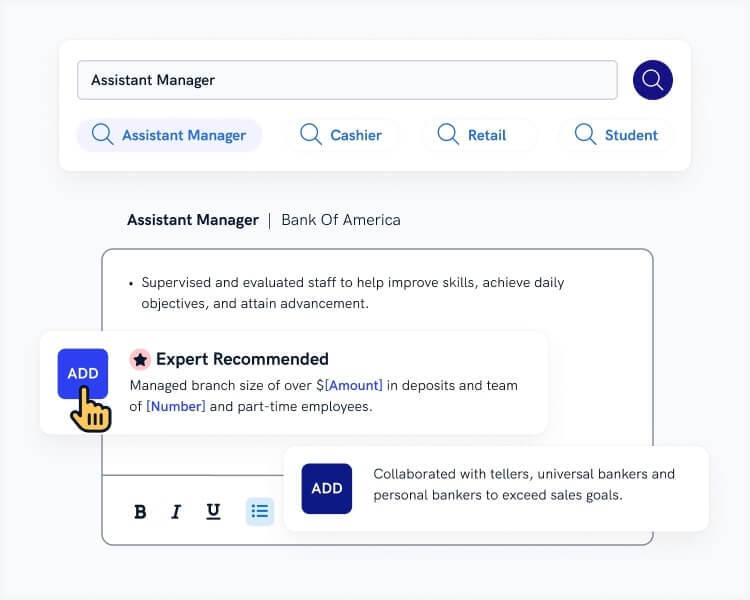How to Write a Graphic Design CV: Examples & Tips
Create your CV nowAs Milton Glaser said, “There are three responses to a piece of design – yes, no, and WOW! Wow is the one to aim for.” You’re just five minutes away from learning how to create the best graphic designer CV that will wow the recruiter.
Read on and you’ll see a professional graphic design CV example that’ll help you create a job-hunting wow moment. Plus, you’ll learn an easy formula for writing a CV for graphic design jobs that will land you more interviews than any other CV you’ve written in the past.
Want to save time and have your CV ready in 5 minutes? Try our CV builder. It’s fast and easy to use. Plus, you’ll get ready-made content to add with one click. See 20+ CV templates and create your CV here.
Graphic designer CV made with our builder—See more CV examples here.
Looking for other CV writing guides? Read more here:
- Creative CV Templates
- Customer Service CV Example
- Data Analyst CV Example
- Free CV Templates
- How to Write a CV
- Medical CV Example
- Receptionist CV Example
- Retail CV Example
- Shop Assistant CV Example
- Waiter / Waitress CV Example
Graphic Designer CV Example
Sam Joshi
Ph: 0777 777 7777
Email: samjoshi_zety@gmail.com
Innovative graphic designer with 5+ years’ experience in a variety of exciting projects. Promoted client events by designing posters, newspaper ads and other promotional materials with a 100% record of meeting deadlines. Strong communicator with the ability to efficiently outsource to copywriters and web developers. Looking to contribute to projects and further success of Company XYZ.
Work Experience
Graphic Designer
The Fortron Agency, London
September 2017–Present
- Created an average of 12 advertisements and logos weekly in InDesign including flyers and banners for corporate clients.
- Managed 8-10 graphics editing projects per day including retouching, colour correction and enhancing/arranging photos for use in final production.
- Supervised project team of three that developed large-scale print projects with 100+ pieces.
- Ensured compliance with agency design guidelines.
- Reviewed design models, drawings and design documents for quality, accuracy, and satisfactory completion.
Junior Graphic Designer
Shaftesbury Events, London
October 2014–September 2017
- Promoted client events by designing posters, newspaper ads and other promotional materials with a 100% record of meeting deadlines.
- Improved clients’ brand identity by advising and applying design principles, typography, colour theory, and composition to their promotional materials.
- Established trusting relationships with key clients, attracting two new long-term contracts to the business.
- Assisted in marketing strategies and research.
Education
BA (Hons) Graphic Design, September 2011–June 2014
Leeds Arts University, Leeds
Skills
- Software Suites. Created layouts inInDesign, CorelDRAW and QuarkXPress.
- Typology. Utilising font psychology to fit clients’ corporate image and project requirements.
- Time management. Adept in utilising agile methodologies and Scrum framework to meet project deadlines.
- HTML. Created basic HTML documents for web design projects for collaborating with front-end developers.
- Print knowledge. Keen eye for taking into account bleed and incorrect CMYK colour settings.
Awards
- Nominated for Drum Awards—Young Designer of the Year 2017
Now, here’s the job-winning graphic design CV formula:
1. Use the best format for your graphic design CV
A graphic design CV is your first chance to show off your design thinking and attention to detail. Whether you’re aiming for a role in print, digital, UI, or branding, your CV should reflect your creative skills and experience.
You may be tempted to go bold with layout and typography, but remember—recruiters scan CVs in about 8 seconds. Even in a creative industry, your graphic designer CV still needs to follow a few simple rules. Here’s what you need to do.
- Choose the right CV format. Usually, the best choice for your graphic design CV is chronological format. It’s the ‘classic’ style that recruiters know best.
- Use a clean CV layout. Set margins to one inch on each side, left align only (don’t use justification) and double space between sections. This creates plenty of white space, which as you know keeps it easy to read.
- Pick a professional CV font. Helvetica, Calibri and Arial are reliable choices.
- Be minimalist. Your CV length should be a maximum of two pages.
- Save your CV as a PDF to keep your hard-won layout intact.
Will you be writing a mainly gig-based or freelance graphic designer CV? Then you might want to consider a skills-based CV.
Read more about CV Layout: How to Layout a Professional CV
2. Write a graphic designer CV personal statement
Your CV personal statement (also called a personal profile) is the first thing recruiters will see, so it needs to make a strong impression.
In just 3–4 sentences, you’ll want to show who you are, what you bring to the table, and what your goals are. Think of it as the top of your visual hierarchy—the hook that encourages them to read on. Ask yourself:
- Who are you as a graphic designer?
- What can you offer the employer?
- What are your career goals?
If you’re an experienced designer:
- List your most relevant design skills, tools, and achievements.
- Compare them with the job advert and pick the top 3–4 points that match.
- Craft your personal profile around those, tailored to the role.
If you’re a junior designer or changing careers:
- Focus on transferable skills from education or previous roles.
- Show your enthusiasm for the role and mention what attracts you to the employer.
- Keep the tone confident, and your offer, genuine.
In both cases, you’ll find this section easier to write if you leave it until last. It’s much easier when you’ve got your experience, skills and education all set out and ready to refer to.
3. Highlight your work experience in a CV for a graphic designer
Your work experience section is the core of your graphic design CV. Employers want someone who can hit the ground running. This is where you show them you’re that designer.
Follow these steps to make it count:
- Use the reverse-chronological CV style. List your most recent role first, then work backwards through your career.
- For each job, include: job title, employer name, dates of employment (use “present” if you’re still there), and up to six bullet points.
- Begin each bullet with a strong CV action verb—think designed, developed, led, delivered.
- Focus on measurable achievements, not just tasks. Show what you did and how well you did it.
- Use the PAR (Problem Action Result) method to structure your examples. This helps turn tasks into impactful accomplishment statements.
- Tailor your points to the job description. Highlight the skills and experience the employer is asking for.
Looking for some more design tweaks to create the perfect CV? Check out our guide: 20+ CV Tips and Advice for Job Application Success
4. Include an education section on your graphic design CV
Every graphic design CV needs an education section. Regardless of how experienced you are, you still need to show your design knowledge has its roots in formal training. Here’s how you do it.
- Include the school/university name, years attended, and the name of your degree/diploma. If you’re still studying include your expected graduation date.
- If you have post-graduate qualifications, follow reverse-chronological order and put the degree you completed most recently first.
- If you’ve just graduated and don’t have much experience then change the order of your CV and put this section before your work experience section. Then, include bullet points for relevant coursework, honours, club memberships, awards, etc.
5. Show Off Your Graphic Designer CV Skills
Being a graphic design professional requires an ever-expanding array of skills. Apart from classic visual design there’s a need for mastery of software suites and knowledge of web programming. The key to writing a great CV skills section is showing the ones that match the job.
Here’s how to choose the right graphic design skills for your CV:
- Read the job ad carefully. Create a list of which skills the employer is looking for.
- Make a list of your own skills—pull from your work history, education, and portfolio.
- Compare both lists and pick 5–10 skills that match best.
- Include a mix of soft skills and hard skills.
- For each one, add a short note or example showing how you use it. For example: Software Suites – Designed marketing layouts using InDesign, CorelDRAW, and QuarkXPress.
These skills would make a great addition to a graphic design CV.
Graphic designer skills for CV
- Communication skills
- Creativity
- Time management
- Problem solving
- Marketing
- Typography
- Infographics
- Colour theory
- Print knowledge
- HTML/CSS
- Software
- Interpersonal skills
When making a CV in our builder, drag & drop bullet points, skills, and auto-fill the boring stuff. Spell check? Check. Start building your CV here.
When you’re done, Zety’s CV builder will score your CV and tell you exactly how to make it better.
6. Include additional sections to your graphic design CV
Sometimes, more is more. Especially when it helps you stand out from 118 other candidates gunning for each job opening. Adding a few well-chosen extra sections to your graphic designer CV can give you an edge.
Here're some popular choices:
- Language skills—Knowing another language is a huge asset, especially in global or client-facing design roles.
- Volunteering—82% of hiring managers prefer candidates with volunteering experience. It shows initiative and people skills.
- Freelance projects—If you’ve done any freelance work, even short-term gigs, list them to showcase range and independence.
- Awards and achievements—Design competitions, recognitions, or even certifications can back up your skills.
- Hobbies and interests—Only include these if they’re relevant (e.g. photography, illustration, or creative writing).
7. Add a cover letter to your graphic designer CV
Miss out a crucial element and you risk creating asymmetry and an unbalanced design. For a CV that last missing element is a cover letter. Yes, cover letters are still important. In fact, more than half of employers say they’re a must-have.
This is how to write a cover letter for graphic design jobs:
- Use the correct cover letter format.
- Start your cover letter with a ‘hook’. Show passion for the role and include a standout achievement.
- Prove your experience and design skills make you the right fit.
- End with a clear call to action, asking to meet or discuss the role further.
- Stick to the right cover letter length of one A4 page at most.
Follow up if you haven’t heard back after a week. A polite email or call shows initiative and keeps your application front of mind.
And now you know how to create the perfect graphic designer CV.
Plus, a great cover letter that matches your CV will give you an advantage over other candidates. You can write it in our cover letter builder here. Here's what it may look like:
See more cover letter templates and start writing.
Thanks for reading. What did you think of our graphic design CV template? Got any challenges with your own CV for graphic designer? If you’ve got any questions at all, please use the comments section below. I’m looking forward to hearing from you.
About Zety’s Editorial Process
Our editorial team has thoroughly reviewed this article to ensure it follows Zety’s editorial guidelines. Our dedication lies in sharing our expertise and providing you with actionable career advice that offers you real value. Every year, the quality of our content attracts 40 million readers to our site. But that’s not all – we conduct original research to gain a detailed understanding of the labour market. We take pride in being cited by top universities and leading media outlets in the UK and worldwide.





![Graduate CV: Examples, Template + Writing Guide [2026]](https://cdn-images.zety.com/pages/graduate_cv_example_uk_10.jpg?fit=crop&h=250&dpr=2)
